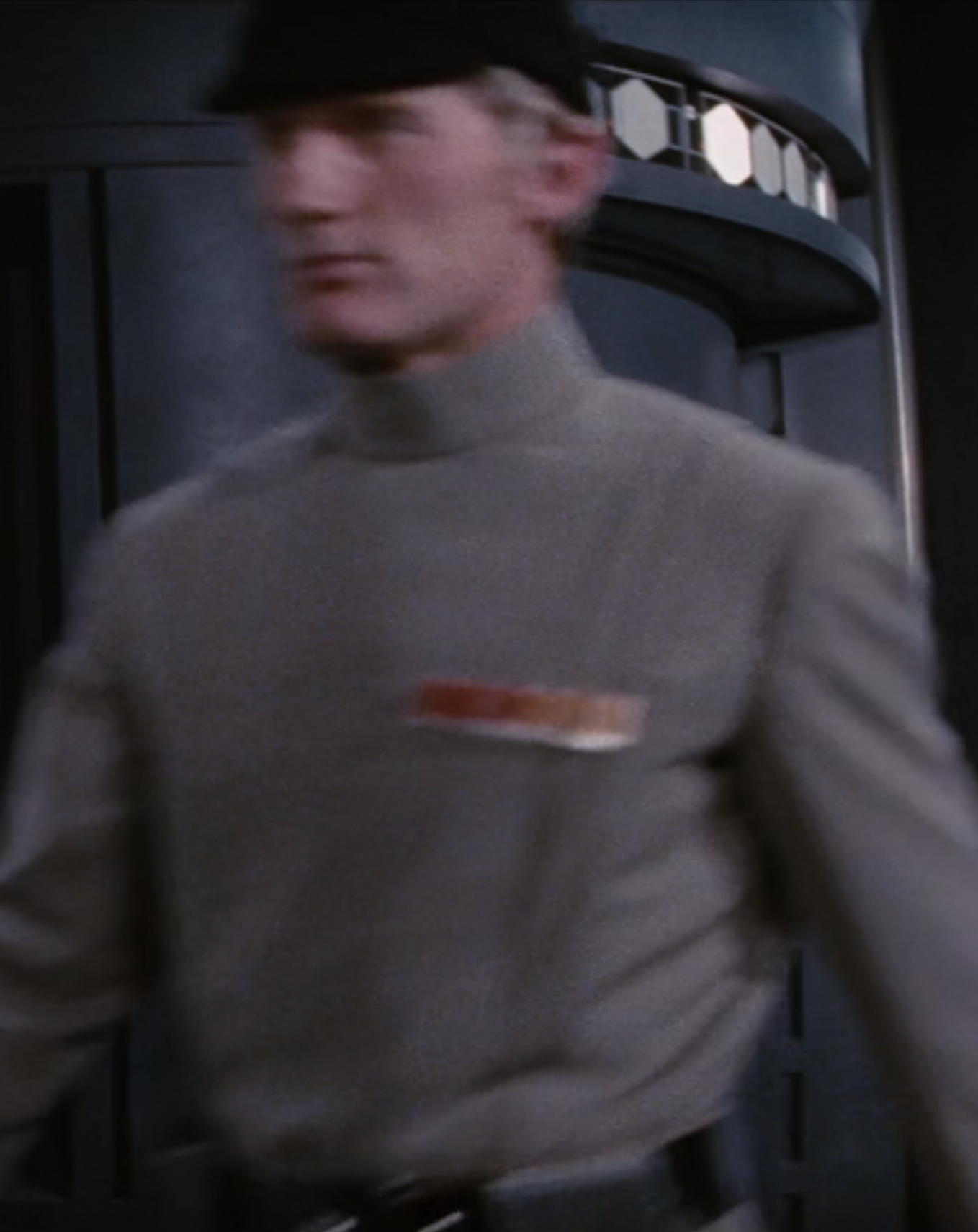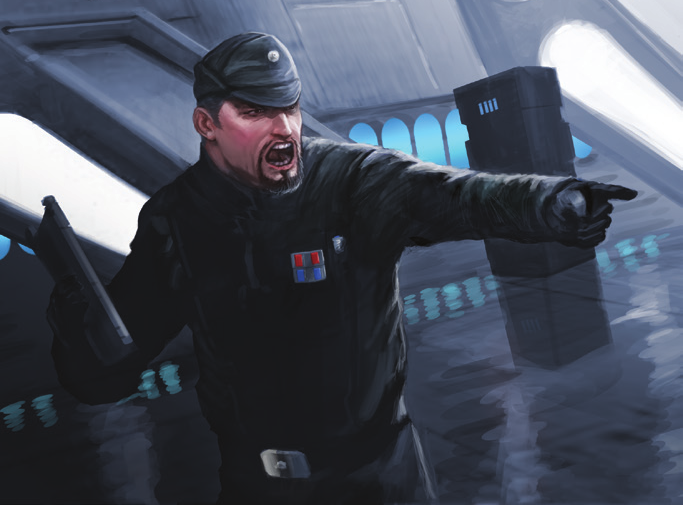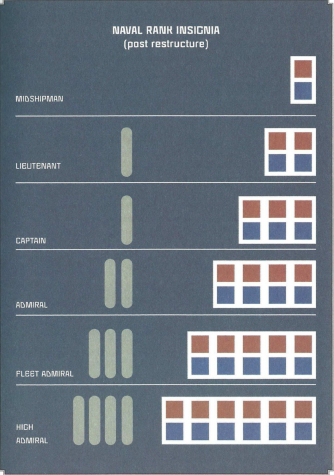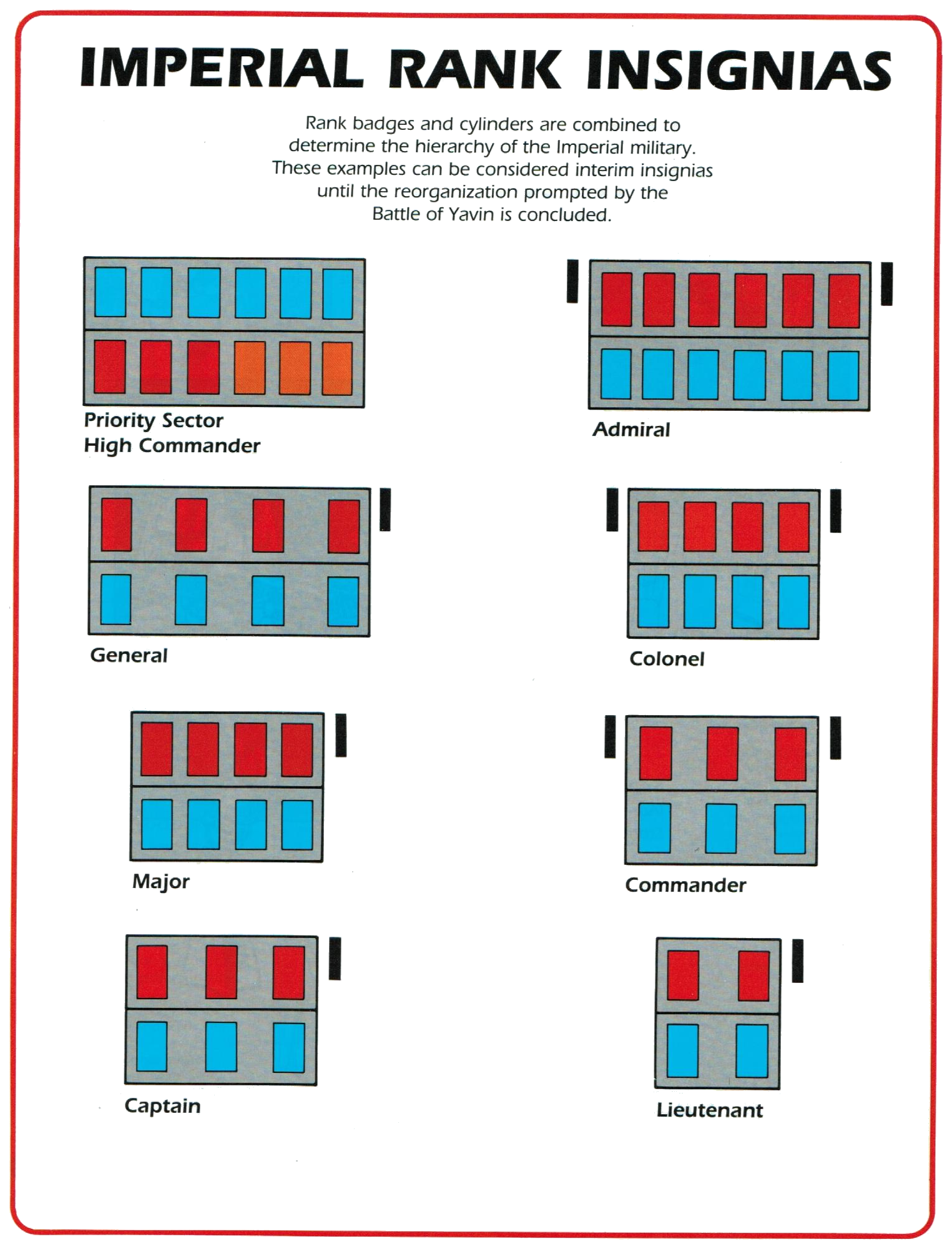Rank insignia plaques were a system of badges used to indicate and distinguish officer rank within the forces of the Galactic Empire. It was not restricted to the Imperial Military during the time of the New Order. Political organizations such as COMPNOR also made use of this system. Rank insignia plaques were also used by the Galactic Republic in the last years of the Clone Wars.
A rank plaque consisted of a rectangular metal chrome plate fitted with raised colored squares. It was designed to be worn on the top left torso region of Imperial service uniforms, dress uniforms and even on battle armor. If an officer's function demanded code cylinders (containing encrypted data and high level access codes), they were worn on the shoulders of the officer. As code cylinders indicated importance, they were sometimes referred to as "rank cylinders". The colored squares of rank plaques were typically red, blue or gold, and arranged in single or double rows. Very low ranking officers, like Imperial Academy cadets, were commonly fitted with only a single colored square, while top ranking officers, like Grand Moffs, displayed up to 12 squares. These plaques were also used in the Republic Navy. Because of the colorful display, fellow servicemen could easily recognize rank from a distance.

Imperial officers wore rank plaques with a variety of uniforms. Some were single-rowed plaques, while others were double-rowed.
There were many similarities among the rank plaque designs of the Imperial Navy, the Imperial Army, and the Imperial Stormtrooper Corps. For instance, all three military branches had lieutenants displaying their rank with two red squares next to 1 blue square. There were also many sub-branches, specialized units and divisions within the imperial military. Many of these deviated from the mainstream double rowed, red and blue rank insignia. The majority of the alternate rank displays were arranged in single rows. It was not uncommon to see Imperial Navy, Army and Stormtrooper officers wearing single rowed rank plaques. ISB officers of COMPNOR also made use of single rowed rank plaques. There have also been alterations to the plaque, such as in the immediate aftermath of the Battle of Yavin, where a temporary ranking system was implemented until the Imperial Military was reorganized as a result of the events of the Battle of Yavin. The Stormtrooper Corps do not generally wear rank insignia plaques while on field duty and instead have their officers during those times wear either specialized markings on the armor itself or otherwise wear special pauldrons indicating their command rank, with one of the few exceptions to the rule being Cold assault stormtroopers, who wear rank insignia plaques on the breastplate indicating their rank.

An Imperial officer with the rank of lieutenant
The Imperial Navy utilized plaques to signify their rank, which typically involved red and blue squares, on the top and bottom of the plaque, respectively, as well as code cylinders. The specialist officers had their own variants, although the specific rank is different, and the code cylinders, unlike the formal positions and/or line officers, solely served as a decorative purpose. Although they are generally absolute, the extent of relationship between a position and rank has at times varied. In general, there were three different categories for Imperial ranks: Position, which dealt with current assignments to a specific ship or unit; Line ranks, held by line officers or the men who command the bridge crew, captain ships, and hoist their flag over fleets; and specialist ranks, for personnel of the Flight, Support, and Engineering branches. The line rank and position generally shared the same placard, but the specialist ranks had their own plaques.
Midshipmen were the lowest position within the Imperial Navy, and were known to hold the rank of Ensign in line ranks. They held two squares. The position of Lieutenant was held by all but the commanding officer of the ship, regardless of rank, and the ranks included in the position included Junior Lieutenant, Senior Lieutenant, Junior Commander, and to some extent Senior Commander. They held three squares as well as one code cylinder.

A rank guide, organizition by position, not line rank.
The position of Captain was always held by the commanding officer of an individual ship, which was held by Captains or Senior Captains and, to some extent, Senior Commanders. In addition, Senior Captains also commanded small groups of ships composed of escorts or light cruisers, groups small enough to not qualify under the squadron level. They held six squares and, depending on the specific relationship between the position and rank, can hold one or two code cylinders. The plaque itself also is shared to some extent with the position of Admiral, Commodore, or Commander.
The position of Admiral, or more specifically System Admiral, is shared with the positions of Commodore and Commander, and were generally held for the System Forces of the Imperial Navy. These positions are technically different from a squadron commander due to the System Forces being ranked between a Fleet and a Squadron (the latter being the main practical sub-unit of the former). However, as most of the System Forces in practice contained only one squadron, the System Admiral and the Squadron Commander was often the same officer. Commanders, in addition, were an unofficial way of addressing the Admiral, the official position of the squadron. Because of the narrow view, it shared Captain placard and its higher rank of Fleet Admiral, in addition to its own plaque, which is itself composed of eight squares and two code cylinders. The line rank equivalents were the Senior Captain (to some extent), the Rear Admiral, and the Vice-Admiral (to some extent). The Fleet Admiral commanded a fleet, and is usually the senior officer of a sector. It shared the line ranks of Vice Admiral and Admiral, which was composed of ten squares and three code cylinders.

An Imperial Navy Rank Guide.
The High Admiral was an honorary position within the fleet, alongside the higher up Warlord, and were often held by either Grand Admirals or Moffs. The High Admiral had twelve squares, as well as four code cylinders, and shared its rank with Admiral.
The specialist ranks were for personnel of the three primary branches within the Imperial Navy: The Flight Branch, the Support Branch, and the Engineering Branch, and held a similar ranking system to that of the Imperial Army. The very few promoted beyond General were promoted into the line at the ranks of vice admiral, although they generally retained the honorific branch titles of air marshal, war commissar, and master engineer. Their ranks, besides General, included Colonel, Major, Commander, Captain, Lieutenant, and Officer, which were the equivalent of Rear Admiral, Senior Captain, Senior Cmdr., Junior Cmdr., Senior Lt., Junior Lt., and Ensign, respectively. For the junior ranks of Captain and lower, their titles were also prefixed, depending on the specific branch they belonged to, by flight, support, or engineering, with Flight Branch pilots also having their own positional titles: Squadron Leader, Wing Commander, and Group Captain.
Besides the above, specialist officers also possessed additional key code cylinders depending on their duties: Generals with large base or project commands often received code cylinders of a squadron or fleet commander, and TIE squadron leaders, namely Flight Captains, featured the insignia of a ship's captain, as fighter units are considered the equivalent of a small ship command. The specialist officers plaques, in order from Officer to General, included four squares, four squares plus two code cylinders, six squares, six squares plus two code cylinders, eight squares plus one code cylinder, eight squares plus two code cylinders, and four vertical pairs of squares separated from each other plus one code cylinder.
Although the code cylinders of the specialists in the Imperial Navy served no purpose other than decoration, the line ranks and positions featured an additional use for them: besides relating to their fleet responsibilities, the code cylinders were designed to regulate computer usage aboard Imperial Navy vessels. They were not usually worn when off-duty, and new code cylinders were assigned with every new assignment.
The position of High General was indicated by a single strip of six red squares and three code cylinders, although it sometimes was shown as having the same colors as a Colonel and a standard General. A Chief in the Imperial Army had four gold squares on the right, and two red squares on the left, with two code cylinders., while a standard general, sometimes, depicted as a full set of six gold squares, although it sometimes was also the rank of a captain.
The rank of Commander for the Stormtrooper Corps, when in officer uniform, was indicated by four blue squares on the left and two red squares on the right, with two cylinders.
Over a hundred years after the death of Emperor Palpatine, under the Fel Empire and later during the Darth Krayt Galactic Empire and the Empire-in-exile, rank plaques of similar design were still in use. At this time the Imperial forces wore the insignia on the top center torso region and alternately on the collar of uniform.
In the Star Wars movies, the seniority of Imperial officers is generally indicated by increasing numbers of rank squares and code cylinders, but there is no easy way to extrapolate a simple hierarchy of ranks and insignia, and no direct evidence that George Lucas or the movie costume designers and production crew ever created a strict system. Only between The Empire Strikes Back and Return of the Jedi are there many points of contact in terms of the specific insignia used, but even here, there are distinct incongruities.
It is important to note that a spoken title may not be synonymous with an officer's actual rank. For example in a time of war it is common for officers to be promoted and/or transferred often. Thus a commander may be referred to as captain if he were acting as captain in a "graded" captain's absence, even though the title confers no inherent promotion of that commander. Additionally when two or more officers aboard a naval vessel would have the grade of captain, "graded" captains not serving as commanding officer may at times assume the title of "commander" out of respect to the adage that a ship may have only one "captain". Also, a commanding officer may assume the senior title of "commodore" or "commander" as a sign of command, particularly in situations where the commanding officer would command a formation of more than one vessel, or be in command of several ground units. This would also be true on a large project, such as the Death Star, where titles may not synchronize with actual ranks and rank badges to reduce confusion along the chain of command.
The ranking system for the Imperial Navy was eventually given somewhat of a complete ranking guide in the 2012 guidebook The Essential Guide to Warfare, which featured a table for the various accounted for ranks alongside pictures of the plaques and also cited additional ranks not mentioned or pictured in the table itself. According to the guide's co-author Paul R. Urquhart, he had a lot of fun doing the section, and also cited that the films primarily did the ranking to indicate a character of importance, and also cited that in-universe, a high-ranked officer is easier to identify regarding a plaque on a 20km super star destroyer. He also briefly referenced the errors in Return of the Jedi, but commented that, while the table primarily covered the ranks in Empire and Jedi, the spaces themselves would be enough to fill in for the ranks seen in A New Hope, and also mentioned that he had accounted for all except for possibly a few cylinders from the comics. Likewise, he mentioned that he based the ranking systems off the movies, and that it wouldn't match the conventional ranking systems of the American forces, citing that ranking conventions were different from each country in each period of time, whether it was between America and the United Kingdom, or between either of them or the Imperial Russian Army and/or the Waffen-SS in Nazi Germany. He also indicated that he had wanted to extend the categorization for the Army and Stormtrooper Corps, but decided that the Navy would have covered it enough, as Star Wars was meant for kids. He also planned to have a rank called Field-Zeugmeister, although in the final version, it was replaced with Master Engineer. Jason Fry, in his endnotes on the book, added a footnoted apology addressed to Urquhart for the change.

Imperial rank insignias as seen just after the Battle of Yavin.
The rank system used in Expanded Universe material is, in contrast to the films, largely consistent and systematic. While there are a few inconsistencies, a basic hierarchy of ranks and insignia, which first appeared in West End Games sourcebooks for the D6 role-playing game in the late 1980s, has recurred in novels, comics and computer games down to the present day. This system is generally assumed to have originated with the RPG, although it is possible that it may have been based on production notes or costume-design sketches from the films. WEG certainly had access to large amounts of such official material.
Of course, not every aspect of the canon WEG rank system is clear. It is impossible for this simple system to provide an exact match with all the variety of movie badges. In addition, the relationship between Navy and Army ranks and insignia is vague and ambiguous. The bulk of confusion among fans has stemmed from the fact that the rank hierarchy associated with this system inconsistent with the real-world Anglo-American (UK/US) standard. The appearance of Commander ranking between Captain and Major is often remarked on. Nevertheless, the naval rank system of the Rebel Alliance, as well as real-world Scandinavian and other European navies, also places commanders above captains.
The English word commander as well as the word commodore has its origins in the French word commander/commandeur, meaning to command. Historically, the title Commander has generally been used to describe officers in command of military formations or operations. Many European countries adopted several French words and military norms during the 18th century and all the way up to the Napoleonic Wars. The "Commander" title found its way into formal rank designations of several Armies and Navies. With this in mind, Star Wars ranks may have been conceived out of ranking systems of non-Anglo-American origin.
Over time, a number of alternative fanon insignia systems have appeared on the internet. These speculative systems rarely conform to the canon tabulations, and do not always accommodate the full range of specific examples shown in canon material.
Probably the most notable of the various fan-constructed systems is that on the influential Star Wars Technical Commentaries website. This offers detailed discussions of ranks and insignia, but although hypotheses from these websites have found their way into the general fan consciousness, they have no canon status, and involve a number of important assumptions incompatible with EU material.
Lastly, mention should be made of the supposed rank badge blooper in Return of the Jedi. It is often said in fan discussions that a wardrobe mistake resulted in the actors playing Imperial officers being given costumes with the wrong insignia, but there appears to be no official source that confirms this.
What is clear is that Kenneth Colley is once again wearing the insignia which he wore when his character was a Captain, while Michael Pennington as Moff Jerjerrod shares his badge and cylinder combination with a (presumably rather more junior) officer in the Endor garrison. But it is unclear whether the inconsistency here is really a "blooper," or just another change in the usage of insignia, like the wholesale discontinuity between the first two movies.
For a blooper to exist would also imply that the production crew were working with an idea of what rank insignia were appropriate to certain positions–but what can be said for sure is that much remains uncertain or ambiguous about the processes that have given rise to the complex system of rank insignia used in canon material.
- Imperial Sourcebook
- Death Star Technical Companion
- Wanted by Cracken
- Cracken's Rebel Operatives
- Dark Forces Manual: Coded Transmissions
- Dark Forces Official Player's Guide
- Flashpoint! Brak Sector
- Star Wars Handbook 1: X-Wing Rogue Squadron
- Star Wars: The Visual Dictionary
- The Official Star Wars Fact File4
- Star Wars: The Complete Visual Dictionary
- "25 Years of Return of the Jedi!" — Star Wars Insider 105
- The Complete Star Wars Encyclopedia
- Star Wars Character Encyclopedia